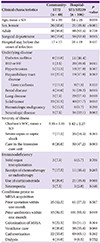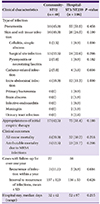1. Saiman L, O’Keefe M, Graham PL 3rd, Wu F, Saïd-Salim B, Kreiswirth B, LaSala A, Schlievert PM, Della-Latta P. Hospital transmission of community-acquired methicillin-resistant
Staphylococcus aureus among postpartum women. Clin Infect Dis. 2003; 37:1313–1319.

2. Valsesia G, Rossi M, Bertschy S, Pfyffer GE. Emergence of SCC
mec type IV and SCC
mec type V methicillin-resistant
Staphylococcus aureus containing the Panton-Valentine leukocidin genes in a large academic teaching hospital in central Switzerland: external invaders or persisting circulators? J Clin Microbiol. 2010; 48:720–727.

3. Seybold U, Kourbatova EV, Johnson JG, Halvosa SJ, Wang YF, King MD, Ray SM, Blumberg HM. Emergence of community-associated methicillin-resistant
Staphylococcus aureus USA300 genotype as a major cause of health care-associated blood stream infections. Clin Infect Dis. 2006; 42:647–656.

4. Davis SL, Rybak MJ, Amjad M, Kaatz GW, McKinnon PS. Characteristics of patients with healthcare-associated infection due to SCC
mec type IV methicillin-resistant
Staphylococcus aureus
. Infect Control Hosp Epidemiol. 2006; 27:1025–1031.

5. Strandén AM, Frei R, Adler H, Fluckiger U, Widmer AF. Emergence of SCC
mec type IV as the most common type of methicillin-resistant
Staphylococcus aureus in a university hospital. Infection. 2009; 37:44–48.

6. Vidal PM, Trindade PA, Garcia TO, Pacheco RL, Costa SF, Reinert C, Hiramatsu K, Mamizuka EM, Garcia CP, Levin AS. Differences between “classical” risk factors for infections caused by methicillin-resistant
Staphylococcus aureus (MRSA) and risk factors for nosocomial bloodstream infections caused by multiple clones of the staphylococcal cassette chromosome mec type IV MRSA strain. Infect Control Hosp Epidemiol. 2009; 30:139–145.

7. Park SH, Park C, Yoo JH, Choi SM, Choi JH, Shin HH, Lee DG, Lee S, Kim J, Choi SE, Kwon YM, Shin WS. Emergence of community-associated methicillin-resistant
Staphylococcus aureus strains as a cause of healthcare-associated bloodstream infections in Korea. Infect Control Hosp Epidemiol. 2009; 30:146–155.

8. Kim ES, Lee HJ, Chung GT, Lee YS, Shin DH, Jung SI, Song KH, Park WB, Kim NJ, Park KU, Kim EC, Oh MD, Kim HB. Molecular characterization of methicillin-resistant
Staphylococcus aureus isolates in Korea. J Clin Microbiol. 2011; 49:1979–1982.

9. Park KH, Chong YP, Kim SH, Lee SO, Choi SH, Lee MS, Jeong JY, Woo JH, Kim YS. Community-associated MRSA strain ST72-SCC
mecIV causing bloodstream infections: clinical outcomes and bacterial virulence factors. J Antimicrob Chemother. 2015; 70:1185–1192.

10. Joo EJ, Chung DR, Ha YE, Park SY, Kang SJ, Kim SH, Kang CI, Peck KR, Lee NY, Ko KS, Song JH. Community-associated Panton-Valentine leukocidin-negative meticillin-resistant
Staphylococcus aureus clone (ST72-MRSA-IV) causing healthcare-associated pneumonia and surgical site infection in Korea. J Hosp Infect. 2012; 81:149–155.

11. Joo EJ, Chung DR, Ha YE, Park SY, Kim HA, Lim MH, Kim SH, Kang CI, Lee NY, Ko KS, Peck KR, Song JH. Clinical predictors of community-genotype ST72-methicillin-resistant
Staphylococcus aureus-SCC
mec type IV in patients with community-onset
S. aureus infection. J Antimicrob Chemother. 2012; 67:1755–1759.

12. Horan TC, Andrus M, Dudeck MA. CDC/NHSN surveillance definition of health care-associated infection and criteria for specific types of infections in the acute care setting. Am J Infect Control. 2008; 36:309–332.

13. Clinical and Laboratory Standards Institutue (CLSI). Performance standards for antimicrobial susceptibility resting; 19th Informational Supplement M100-S19. Wayne, PA: CLSI;2009.
14. Oliveira DC, de Lencastre H. Multiplex PCR strategy for rapid identification of structural types and variants of the mec element in methicillin-resistant
Staphylococcus aureus
. Antimicrob Agents Chemother. 2002; 46:2155–2161.

15. Milheirico C, Oliveira DC, de Lencastre H. Multiplex PCR strategy for subtyping the staphylococcal cassette chromosome mec type IV in methicillin-resistant Staphylococcus aureus: ‘SCCmec IV multiplex’. J Antimicrob Chemother. 2007; 60:42–48.
16. Enright MC, Day NP, Davies CE, Peacock SJ, Spratt BG. Multilocus sequence typing for characterization of methicillin-resistant and methicillin-susceptible clones of
Staphylococcus aureus. J Clin Microbiol. 2000; 38:1008–1015.

17. Alberti KG, Zimmet P, Shaw J. Metabolic syndrome--a new world-wide definition. A Consensus Statement from the International Diabetes Federation. Diabet Med. 2006; 23:469–480.

18. Gillet Y, Issartel B, Vanhems P, Fournet JC, Lina G, Bes M, Vandenesch F, Piémont Y, Brousse N, Floret D, Etienne J. Association between
Staphylococcus aureus strains carrying gene for Panton-Valentine leukocidin and highly lethal necrotising pneumonia in young immunocompetent patients. Lancet. 2002; 359:753–759.

19. Gillet Y, Vanhems P, Lina G, Bes M, Vandenesch F, Floret D, Etienne J. Factors predicting mortality in necrotizing community-acquired pneumonia caused by
Staphylococcus aureus containing Panton-Valentine leukocidin. Clin Infect Dis. 2007; 45:315–321.

20. Kim SH, Park WB, Lee KD, Kang CI, Kim HB, Oh MD, Kim EC, Choe KW. Outcome of
Staphylococcus aureus bacteremia in patients with eradicable foci versus noneradicable foci. Clin Infect Dis. 2003; 37:794–799.

21. Paul M, Kariv G, Goldberg E, Raskin M, Shaked H, Hazzan R, Samra Z, Paghis D, Bishara J, Leibovici L. Importance of appropriate empirical antibiotic therapy for methicillin-resistant
Staphylococcus aureus bacteraemia. J Antimicrob Chemother. 2010; 65:2658–2665.

22. Patel M, Kumar RA, Stamm AM, Hoesley CJ, Moser SA, Waites KB. USA300 genotype community-associated methicillin-resistant
Staphylococcus aureus as a cause of surgical site infections. J Clin Microbiol. 2007; 45:3431–3433.

23. Alvarez CA, Yomayusa N, Leal AL, Moreno J, Mendez-Alvarez S, Ibañez M, Vanegas N. Nosocomial infections caused by community-associated methicillin-resistant
Staphylococcus aureus in Colombia. Am J Infect Control. 2010; 38:315–318.

24. Mangram AJ, Horan TC, Pearson ML, Silver LC, Jarvis WR. Guideline for prevention of surgical site infection, 1999. Hospital Infection Control Practices Advisory Committee. Infect Control Hosp Epidemiol. 1999; 20:250–278.
25. Hermos CR, Sandora TJ, Williams LE, Mosammaparast N, McAdam AJ. Changing epidemiology of methicillin-resistant
Staphylococcus aureus colonization in paediatric intensive-care units. Epidemiol Infect. 2013; 141:1983–1992.

26. Otto M. MRSA virulence and spread. Cell Microbiol. 2012; 14:1513–1521.

27. Chen Y, Chatterjee SS, Porcella SF, Yu YS, Otto M. Complete genome sequence of a Panton-Valentine leukocidin-negative community-associated methicillin-resistant Staphylococcus aureus strain of sequence type 72 from Korea. PLoS One. 2013; 8:e72803.
28. Joo EJ, Choi JY, Chung DR, Song JH, Ko KS. Characteristics of the community-genotype sequence type 72 methicillin-resistant
Staphylococcus aureus isolates that underlie their persistence in hospitals. J Microbiol. 2016; 54:445–450.

29. Cha HY, Moon DC, Choi CH, Oh JY, Jeong YS, Lee YC, Seol SY, Cho DT, Chang HH, Kim SW, Lee JC. Prevalence of the ST239 clone of methicillin-resistant
Staphylococcus aureus and differences in antimicrobial susceptibilities of ST239 and ST5 clones identified in a Korean hospital. J Clin Microbiol. 2005; 43:3610–3614.








 PDF
PDF ePub
ePub Citation
Citation Print
Print




 XML Download
XML Download